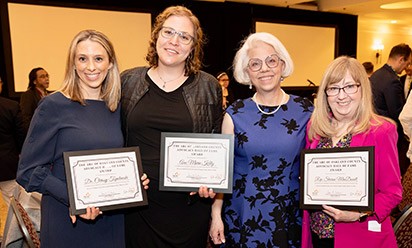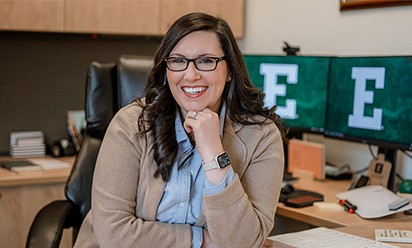Psychology professor highlights need for prompt care for children with autism

YPSILANTI - If you had a child with autism and were told you had to wait nearly six months before receiving care from a board-certified behavioral analyst, what would you do?
Sadly, this scenario is all too common for caregivers, who are left with few resources to help their child begin developing essential skills for daily life. The resulting gap between applying for and receiving applied behavioral analysis (ABA) treatment means children with autism are more likely to develop problematic behaviors and fall further behind developmentally.

As a first step toward resolving this problem, EMU Assistant Professor of Psychology Adam Briggs collaborated with the Autism Alliance of Michigan to create a caregiver survey. The survey had two goals: to assess the prevalence of children with autism spectrum disorders who await ABA treatment; and to better understand the needs of caregivers during the waiting period.
The survey, conducted between winter 2020 and spring 2021, includes responses from 78 caregivers.
“Nearly 75 percent of the caregivers said their child was on a waiting list, with an average wait time of 5.5 months before receiving ABA treatment,” Briggs says. “A shorter waiting period means a problem behavior is more likely to be resolved before it becomes a burden. Children with autism are also more likely to begin developing communication and social skills so they can catch up with their peers.”
Caregivers who waited four months or less for services said they saw no behavioral or developmental changes in their child. However, caregivers who waited more than four months saw their child’s behavior worsen.
“Right now, one in 44 children have autism,” Briggs says. “And of those, 40 percent engage in severe problematic behavior. That must be addressed before the child can work on developing positive behavioral skills. Children with autism are willing and able to learn. But we have to provide the right context for them to learn appropriate behaviors. That’s where applied behavioral analysis comes in.”
Briggs says a lack of board-certified behavioral analysts (BCBA) leads to long waiting periods.
“In Michigan, there is about one BCBA per 27 kids with autism,” he says. “We know that more behavioral analysts are needed, but that isn’t going to happen overnight.
“The caregivers we surveyed said they want some support and training while they’re on a waiting list. This could be through pre-recorded online modules or through in-person workshops. Caregivers want to learn how to effectively manage their child’s behavior and how to reinforce their child’s positive gains. These are teachable concepts that could become huge game changers.”
Briggs and his students are developing these types of training programs in EMU’s Behavioral Analysis Research Lab.
Some of Brigg’s students also helped with various aspects of the caregiver survey. Jaimie Barr developed the pilot survey as part of her undergraduate honors thesis. Doctoral candidate Andi Stephens collected and analyzed the data and helped forge a connection with the Autism Alliance of Michigan. Undergraduates Brittany Loder and Alyssa Miller also provided invaluable assistance, as did EMU Associate Professor of Psychology Angela Staples.
The problems Briggs’ research documents are what originally drew him toward studying applied behavioral analysis.
“As an undergraduate at Western Michigan University, I worked with kids with autism at a local clinic,” he says. “I gained more experience while working with their families and I became close to some of the parents. A parent with a child who would be transitioning out of the program due to age limits asked me, ‘What do we do now? Where can we take our son? What services can we find for him?’ I didn’t know the answers, either.
“That experience really moved me. I felt her fear, uncertainty, and dread and it really made me feel helpless. At that moment. I realized how much caregivers need guidance and access to resources. And it made apparent how much more I needed to learn so I could be a resource to help families in these situations.”
Learn more about Briggs’ survey and its findings on the Autism Alliance of Michigan website.
About Eastern Michigan University
Founded in 1849, Eastern is the second oldest public university in Michigan. It currently serves more than 15,000 students pursuing undergraduate, graduate, specialist, doctoral and certificate degrees in the arts, sciences and professions. In all, more than 300 majors, minors and concentrations are delivered through the University's Colleges of Arts and Sciences; Business; Education; Engineering and Technology; Health and Human Services; and its graduate school. National publications regularly recognize EMU for its excellence, diversity, and commitment to applied education. For more information about Eastern Michigan University, visit the University's website. To stay up to date on University news, activities and announcements, visit EMU Today.
October 19, 2022
Written by:
Jeff Samoray
Media Contact:
Darcy Gifford
dgiffor2@emich.edu
734.487.5375
More Stories

Eastern Michigan University professors receive Disability Advocacy Hall of Fame Award from The Arc of Oakland County Michigan.

Eastern Michigan University alumna, Aleksandra Efimova, leads self-made brand, RP to acquisition by renowned industry leader in dance footwear and apparel, Bloch.

Eastern Michigan University Vice President for Enrollment Management Katie Condon-Martin to help shed light on FAFSA “fiasco” as part of Bridge Michigan Zoom discussion on April 24.

Eastern Michigan University awards Summer Research and Creative Activity Grants.

Eastern Michigan University to launch new Bachelor of Business Administration in Financial Planning and Wealth Management degree.

